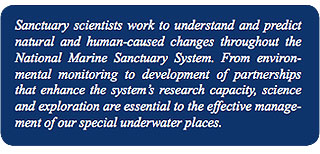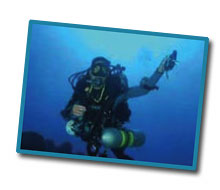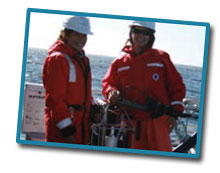|

Researchers Study Impacts of Underwater Noise on Whales
Stellwagen Bank National Marine Sanctuary scientists have developed innova-
tive "sound maps" that analyze the impact of underwater noise on marine life such
as endangered right whales. The researchers combined three years of whale
distribution, ship tracking, recorded sound and environmental data to create the
maps, which can be used to study things like right whale communication in areas
with intense shipping noise versus those without. Improved understanding of how
underwater noise affects marine species will help marine resource managers
better protect our sensitive ocean ecosystems. This collaborative research effort
involving sanctuary staff, Cornell University, NOAA Fisheries Service and Marine
Acoustic Inc. is funded by the National Oceanographic Partnership Program.
Deep-Diving Technology Leads to Species Discoveries
Research divers working off the NOAA ship Hi'ialakai in the Papahānaumokuākea Marine National Monument made several exciting discoveries  as they tested advanced deep-diving technology in fall 2009. The scientists documented at least a dozen new fish in the Northwestern Hawaiian
Islands, collected an undescribed species of butterflyfish, and documented previously unknown deepwater nursery habitats for reef fishes. Over
the course of a month, the researchers conducted 111 dives to depths
of 275 feet, demonstrating the safety and usefulness of the technology
for future deep-sea scientific exploration. This technology will enhance
our ability to learn more about the poorly understood environment deep
below the ocean's surface.
as they tested advanced deep-diving technology in fall 2009. The scientists documented at least a dozen new fish in the Northwestern Hawaiian
Islands, collected an undescribed species of butterflyfish, and documented previously unknown deepwater nursery habitats for reef fishes. Over
the course of a month, the researchers conducted 111 dives to depths
of 275 feet, demonstrating the safety and usefulness of the technology
for future deep-sea scientific exploration. This technology will enhance
our ability to learn more about the poorly understood environment deep
below the ocean's surface.
Reports Provide Baseline of Sanctuary Site Resources
NOAA's Office of National Marine Sanctuaries completed "condition reports" for five sites in the National Marine Sanctuary System in 2009.
Condition reports provide a summary of sanctuary resources, pressures
on those resources, the current condition and trends, and management
responses. The reports include information on the status and trends of
water quality, habitat, living and maritime archaeological resources, and
the human activities that affect them. Last year, condition reports were
released for Flower Garden Banks, Cordell Bank, Channel Islands and
Monterey Bay national marine sanctuaries and the Papahānaumokuākea
Marine National Monument. These documents will serve as a baseline for
monitoring sanctuary resources and are a vital tool in effective sanctuary
management. The reports are available online at http://sanctuaries.noaa.
gov/science/condition/.
Sanctuaries Use Technology to Remove Marine Debris
 Stetson Bank in Flower Garden Banks National Marine Sanctuary is littered with trawl nets, boat anchors, scraps of metal and fishing line. Marine debris like this poses a serious threat to ecosystems throughout the
National Marine Sanctuary System, but it is often located too deep to be
reached by standard scuba diving operations. Flower Garden sanctuary
staff partnered with expert technical divers, who are trained to descend
deeper than standard scuba divers, to remove various debris from Stetson
Bank during a five-day expedition funded by the NOAA Marine Debris Program. Elsewhere, Monterey Bay and Cordell Bank national marine sanctuaries successfully teamed up in October 2009 to locate and remove derelict fishing gear from the seafloor using a remotely operated vehicle. Stetson Bank in Flower Garden Banks National Marine Sanctuary is littered with trawl nets, boat anchors, scraps of metal and fishing line. Marine debris like this poses a serious threat to ecosystems throughout the
National Marine Sanctuary System, but it is often located too deep to be
reached by standard scuba diving operations. Flower Garden sanctuary
staff partnered with expert technical divers, who are trained to descend
deeper than standard scuba divers, to remove various debris from Stetson
Bank during a five-day expedition funded by the NOAA Marine Debris Program. Elsewhere, Monterey Bay and Cordell Bank national marine sanctuaries successfully teamed up in October 2009 to locate and remove derelict fishing gear from the seafloor using a remotely operated vehicle.
|



